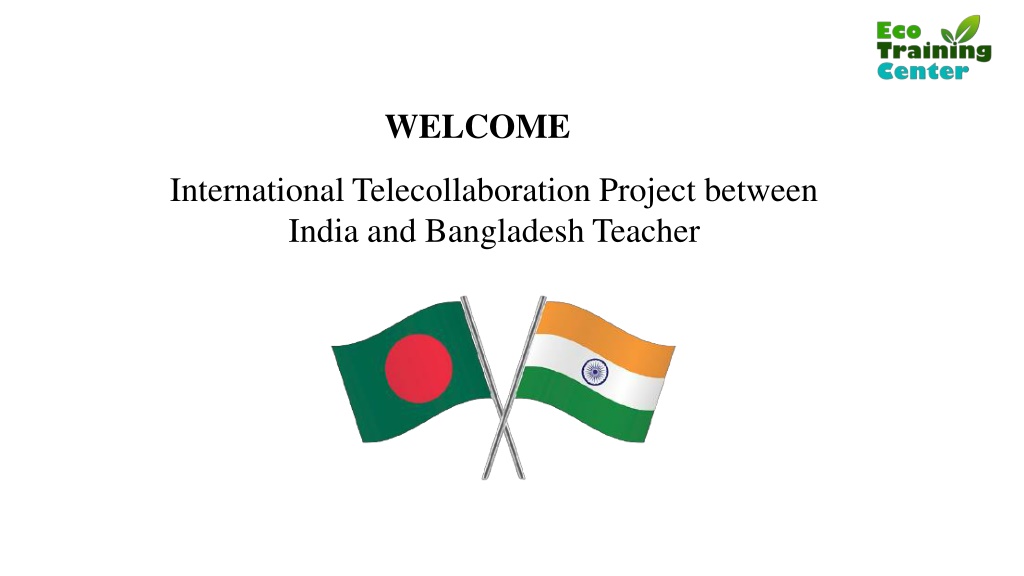Seasons and Climate of Bangladesh: A Vibrant Overview
Bangladesh, known as the land of six seasons, boasts a unique and diverse climate with distinct periods such as summer, monsoon, and winter. The country's weather is characterized by a sub-tropical monsoon climate, featuring hot summers, rainy monsoons, and cool dry winters. This overview delves into the seasonal variations, climate patterns, and unique features that define Bangladesh's climate throughout the year.
Download Presentation

Please find below an Image/Link to download the presentation.
The content on the website is provided AS IS for your information and personal use only. It may not be sold, licensed, or shared on other websites without obtaining consent from the author. Download presentation by click this link. If you encounter any issues during the download, it is possible that the publisher has removed the file from their server.
E N D
Presentation Transcript
WELCOME International Telecollaboration Project between India and Bangladesh Teacher
Teacher Identity Ebnulhassan Tushar B.A (Hons); M.A (English) B.Ed & M.Ed (On Study) Assistant Teacher (English) Ranachandi School and College, Kishoreganj, Nilphamari. Master Trainer (Continuous Assessment) Master Trainer (EVM) Master trainer (Digital Literacy, DNET) Master trainer (National Children & Youth Programming Contest) Master trainer (English-JICCA) Contact no:01719245814 Email:tusharbd89@gmail.com
13th session SDG No. 6 Clean water and Sanitization Seasons and Clean Water and Sanitization
Bangladesh is called the land of six seasons (Sadartu). It has a temperate CLIMATE because of its physical location. Though the climate of Bangladesh is mainly sub-tropical monsoon, ie warm and humid; Bangla calendar year is traditionally divided into six seasons: Grisma (summer), Barsa (rainy), Sarat (autumn), Hemanta (late autumn), Shhit (winter) and Basanta (spring). Each season comprises two months, but some seasons flow into other seasons, while others are short. Actually, Bangladesh has three distinct seasons: the pre-monsoon hot season from March through May, rainy monsoon season which lasts from June through October, and a cool dry winter season from November through February. However, March may also be considered as the spring season, and the period from mid-October through mid-November may be called the autumn.
The pre-monsoon hot season is characterised by high temperature and occurrence of thunderstorms. April is the hottest month in the country when the mean temperature ranges from 27'C in the east and south to 31'C in the west-central part of the country. After April, increasing cloud-cover dampens temperature. Wind direction is variable in this season, especially during its early part. RAINFALL accounts for 10 to 25 percent of the annual total, which is caused by thunderstorms.
Summer Baishakh and Jyaistha (mid-April to mid-June), the two Bangla calendar months, when days are hot and dry. But the influence of summer is usually felt from mid-March. The heat of the sun dries up the waterbodies including the RIVERS, the WETLANDS. The summer days are longer than the nights. (grisma) Comprises and CANALS
The rainy season (barsa) Traditionally spreads over Asadh and Shraban (mid- June to mid-August). However, the rainy season may start from the end of Baishakh and last up to the beginning of Kartik (mid-May to late-October). During the rainy southwest MONSOON winds bring plenty of rainfall (70 to 85 percent of the annual total) and occasionally lasting for days without end without any respite. season, the
Autumn Bhadra and Ashvin (mid-August to mid-October). This is traditionally the season when housewives put out clothes, musty and damp because of the rains, to air and dry in the hot sun of Bhadra. However, the bright day is often punctuated by sudden showers. (sharat) Lasts during
Late autumn (hemanta) The fourth season, covers Agrahayan (mid-October to mid- December). Actually transitional phase between autumn and winter. By mid-November the evenings grow cool. The contrast between the daytime and nighttime temperatures results in heavy dew. This is also the time for colds, cough and fever. Kartik and it is a
Winter (shit) The fifth season and the colder part of the year, in contrast to Summer, the hotter. According to the Bangla calendar it spreads over the months of Paus and Magh (mid- December to mid-February). practically, November through February is the winter season in Bangladesh. Average temperatures in January vary from about 11'C in the northwestern and northeastern parts of the country to 20'C to 21'C in the coastal areas. But
The spring (basanta) The last of the seasons occurs between winter and summer, spreads over the Bangla months Phalgun and Chaitra (mid- February to mid-April). The spring season is very brief in Bangladesh and practically prevails during March only. During this season, winds are variable in direction because this is the time of transition between the northerly or northwesterly winds of winter and the southerly or southwesterly winds of summer.
Clean Water and Sanitization Objective To provide a uniform strategic guideline to the sector stakeholders, including the government institutions, private sector and NGOs, for achieving the sector goal. Goal Safe and sustainable water supply, sanitation and hygiene services for all, leading to better health and well-being.
Steps are being implemented by your government to improve Clean Water and Sanitization 1. Regard water supply and sanitation as human rights. 2. Consider water as a public good that has economic and social value. 3. Ensure drinking water security through integrated water resource management. 4. Promote water supply, sanitation and hygiene components in all WASH development programs in an integrated manner. 5. Adopt a participatory, demand driven and inclusive approach in all stages of WASH service delivery programs. 6. Recognize importance of gender in all WASH activities. 7. Ensure equity in services by giving priority to arsenic affected areas, hard-to-reach areas, water-stressed areas and vulnerable people. 8. Protect human health and water supply and sanitation facilities from the adverse impact of natural and manmade disasters and climate change. 9. Harness the potential resources from solid and liquid wastes. 10. Promote innovations to address technical and social needs.
National and International Organizations 1. Water Aid 2. UNICEF 3. JANO
Thank you so much for your precious time.























